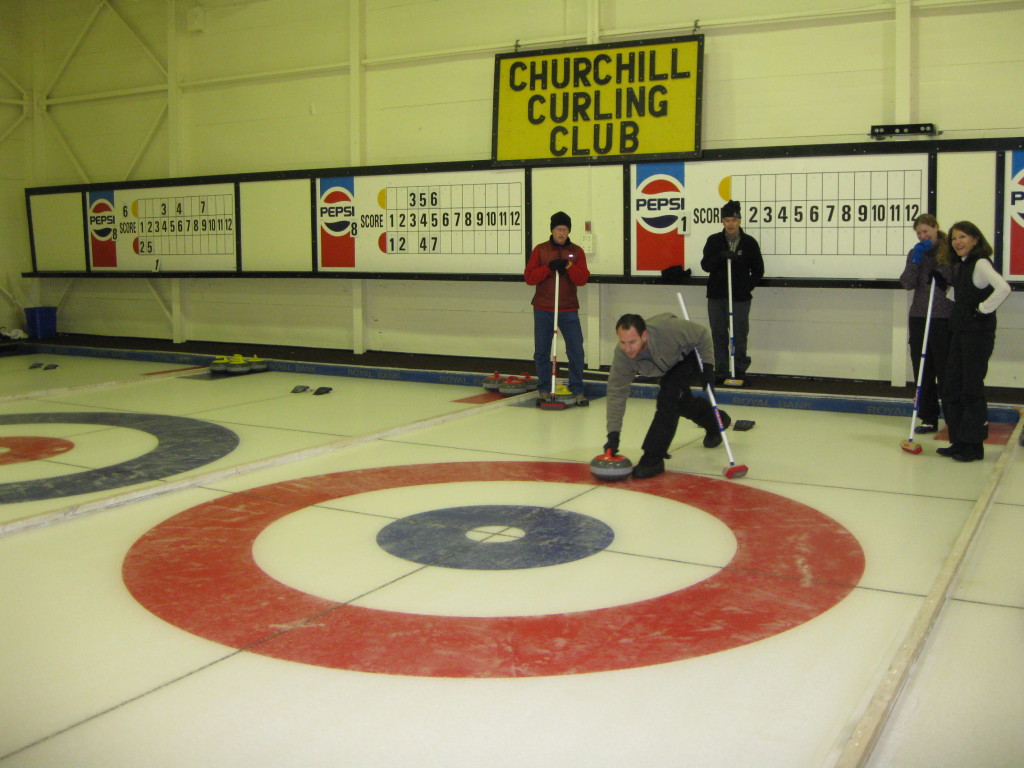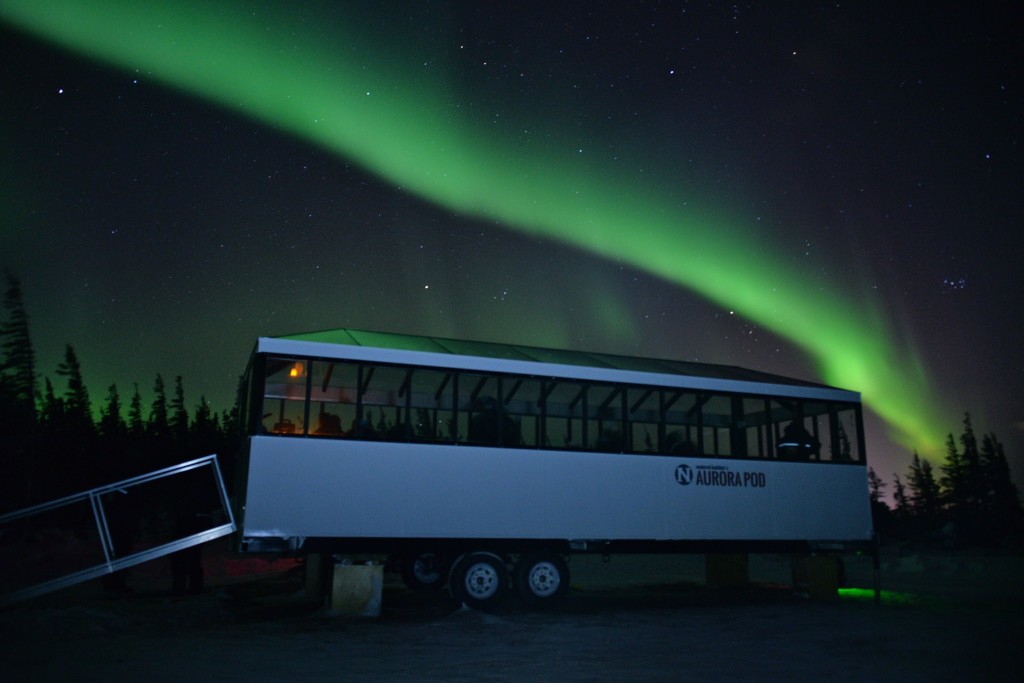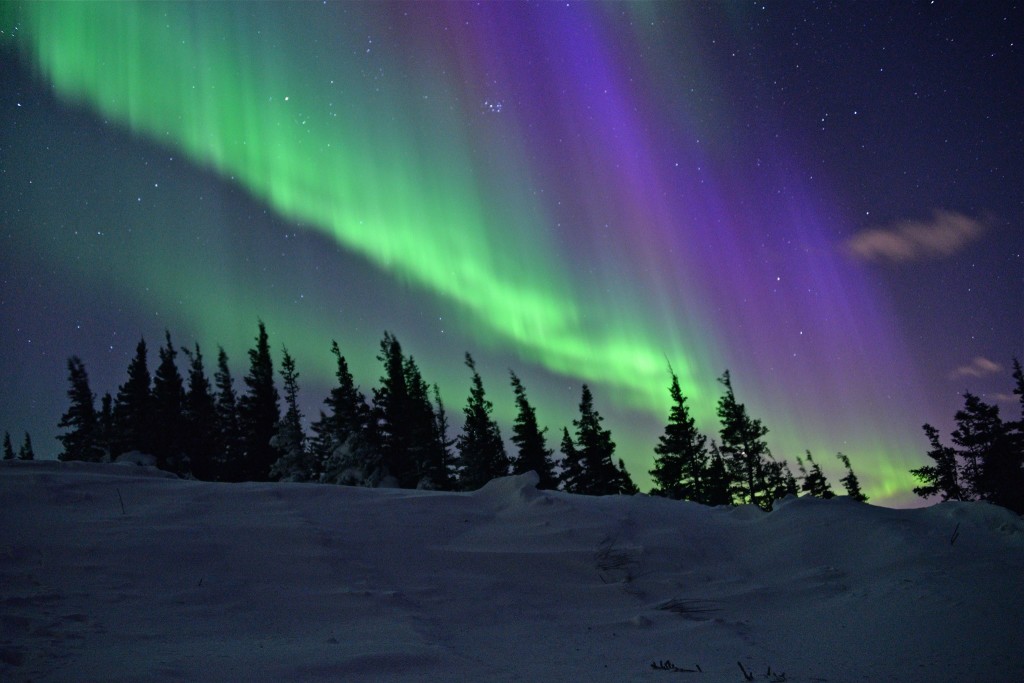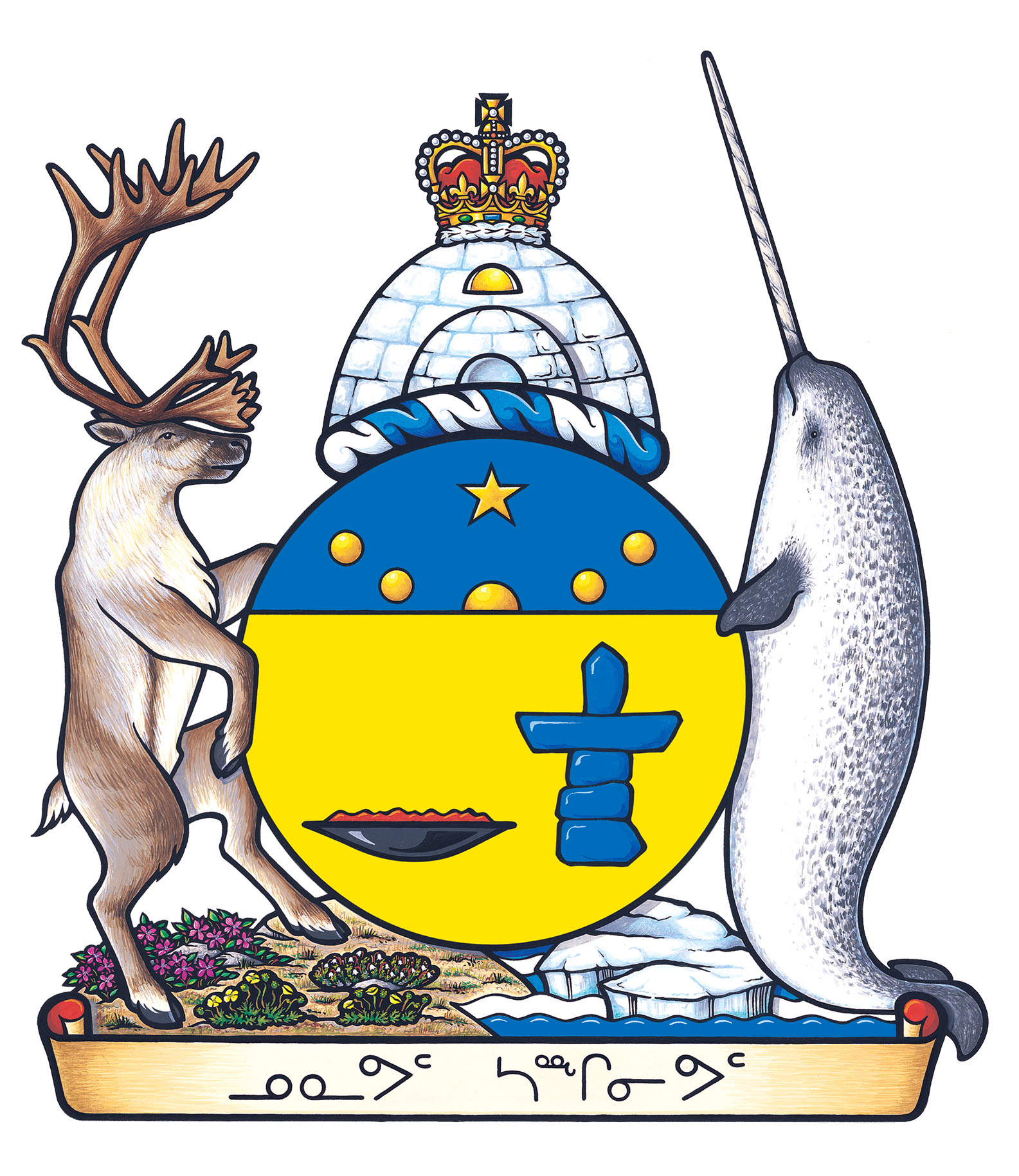by Steve Selden | Apr 28, 2015 | Churchill News
If you have been one of the lucky ones to have tried curling in Churchill while on a wildlife adventure to see polar bears or perhaps the northern lights you have surely had some fun and laughs. The game is slowly spreading in popularity throughout the United States but still remains an enigma to most outside of Canada.

Churchill Curling club participants from Natural Habitat Adventures. Karen Walker photo.
Here are a few secret tips to Churchill curling at the rink inside the town complex. if you have not yet ventured to Churchill, try and include this activity in a future trip to the polar bear capitol of the world.
1. – Unless you know the caretaker of the curling rink personally it will first be a little tricky to even find the somewhat hidden location of the rink and confirm that the ice is in place. Yes, it’s in the town complex but the entrance is located in a less frequented hallway with no exterior windows to view in.

2. – The rules of the game are fairly complex and it will be impossible to pick them all up in one session. The main thrust of the game is to “throw”…rather glide on the ice, eight stones weighing 42 lbs. with handles and try to get closest to the middle “target” button or painted spot underneath the ice. There’s quite a bit of strategy to all the throws leading up to the final stone for each team of four.
3.– Understand that “sweeping” is not the kind you do in your home to clean up. Sweeping in curling involves two of the four teammates sliding ahead of the stone, with special shoe pads, and a special broom, that more accurately resembles a padded squeegee. The idea is to adjust the sweeping in front of the “stone” to manage the speed and for the really experienced sweepers even the direction to a slight degree. I was able to play this position in a local fun “bonspiel” in Churchill once and found it to be very fun and incredibly effective when you get the hang of it.

Churchill curling club conducting league games. Churchill Curling Club photo.
4. – When the skip, the person who throws the stones, yells “hurry”, it is quite entertaining and unique to this sport. What he/she is requesting is for the sweepers to sweep faster in front of the stone and therefore create a smoother and faster surface. The stone will increase in speed by a very slight amount though this may be the difference in a winning shot.
5. – Don’t touch the stones until the shot is over. This includes the sweepers and any teammates waiting at the end of the sheet for the stone to arrive near the target. If anyone on a team touches the stone, even with a broom, the shot is disqualified. Bad etiquette.

Natural Habitat travelers enjoy a curling experience in Churchill. Karen Walker photo.
6. – The curling lounge is almost as important as the curling rink itself. Churchill’s club lounge is a glass enclosed facility that is heated and overlooks the rink from above. A huge part of the curling experience is the camaraderie before, during and after the game or games are being played. Churchill, being such a tight knit town in a generally cold weather environment, especially tends to unite through this activity and gathering space.

Inside the Churchill Curling Club lounge. Churchill Curling Club photo.
7. – Plan on an unforgettable experience of a lifetime. This very well could be the only time in your life that you can experience the fun of playing this age – old sport. When I participated in the tournament in Churchill I was convinced I would return home to the US and find a curling club to join…that was 10 years ago and I still have not played the game again. I did return with a trophy since I was paired up with some of the town’s best curlers. Enjoy it while you have an opportunity!
by Steve Selden | Apr 18, 2015 | Churchill News
You’ve heard the expression “Island time”. In fact you’ve probably uttered it once or twice yourself after experiencing the casual, slowed down lifestyle of people in places that seem to have figured out how to enjoy life…well at least vacation life…usually by the warm, blue water somewhere.

Sundogs in Churchill, Manitoba. Brad Josephs photo.
`
Well “tundra time” is a similar lifestyle but perhaps comes from the opposite end of the weather comfort spectrum. Churchill and the rest of the northern Arctic region of Canada moves at a pace most southerners would call…um…slow. And that’ s being generous. Maybe because the north exists in a cryogenic state of frozen time for a good part of the year there’s really no energy to go fast at any point. Tundra time.
When visiting Churchill, everything moves slower. Restaurant service is slower..hence meals take longer. Vehicles move slower…especially Polar Rovers looking for slow, ambling polar bears. Maybe that’s the key…polar bears set the pace for everything around the area. They are in no hurry to go anywhere…except out on the ice. However, they can’t make the ice form so they instinctively know to take it easy….cause it’s “tundra time” mon!

Polar bear cooling off in Churchill, MB. Natural Habitat Adventures photo.
The train….ha..well anyone that has traveled with Via rail along the Hudson Bay Railway knows the literal definition of “tundra time”. The train tracks often turn a 36 hour trip into a 42 hour trip or more. Why? Because the tracks wind across the tundra that contains permafrost….icy ground. When that icy permafrost heats up and melts a bit, especially in summer, the tracks move slightly and a speeding train has to slow down so to not exert too much force on the steel rails and then end up on ..er..the tundra…stopped in the middle of nowhere. Tundra time.
Most of all the people in Churchill move slower. Churchillian’s by and large are not going far. Well, they can’t drive far as there are no roads out of town unless you want to go to the Churchill Northern Studies Center or a bit further out to Twin Lakes. People in Churchill actually have time to talk with one another, not email or telephone. They actually meet at Gypsy’s or the Seaport Hotel and sit and talk for sometimes hours and enjoy multiple cups of coffee. There’s a “local table” at Gypsy’s up front that is just for that…talking….slowly … and in person. Tundra time.
Nearly everything in the north operates on tundra time. We should all experience it once in awhile.
by Steve Selden | Mar 18, 2015 | Churchill Photography
I was going to do a wrap – up on the Hudson Bay Quest but just couldn’t resist sending these along to everyone. These photographs of incredible northern lights by Natural Habitat’s Alex De Vries – Magnifico are magnificent!
The increased solar flaring last night is supposed to continue over the next few days so keep looking up. If the sky is clear, the southern part of Canada as well as some regions of the United States should get a glimpse of the aurora.

Natural Habitat’s Aurora Pod in Churchill with amazing northern lights. Alex De Vries – Magnifico photo.

Spectacular full sky display of northern lights. Alex De Vries – Magnifico photo.

Northern lights shimmering above the boreal forest. Alex De Vries – Magnifico photo.

Natural Habitat photographers outside the aurora pod in Churchill. Alex De Vries – Magnifico photo.

Northern lights above the aurora pod. Alex De Vries – Magnifico photo.
Spectacular northern lights can be seen in March from Natural Habitat’s Aurora Pod!
by Steve Selden | Jan 23, 2015 | Churchill News
It’s hard to believe that Canada’s newest territory is almost 16 years old. April 1, 1999 was the official date Nunavut separated from the Northwest Territories. Comprising a major portion of Northern Canada as well as most of the islands in the Arctic region, Nunavut is the fifth – largest country sub division in the world. Nunavut borders with Manitoba and the waters of the Hudson Bay are included in its borders.

The capital is Iqaluit, formerly Frobisher Bay on Baffin Island. Other major communities include the regional centers of Rankin Inlet and Cambridge Bay. In the far north, Nunavut also includes Ellesmere Island as well as the eastern and southern portions of Victoria Island in the west as well as Akimiski Island in James Bay in the far south. It is the only region of Canada that is not connected to the rest of North America by highway.
The youngest territory is the least populous though largest in overall area of all the provinces and territories of Canada. With a mostly Inuit population of nearly 32,000, Nunavut is a sparsely settled region about the size of Western Europe. Alert, the northernmost inhabited place in the world, is also a part of Nunavut.

The territory of Nunavut. Vabmanagement.com. image.
The territory includes all of the islands in Hudson Bay, James Bay and Ungava Bay. If Nunavut were a country, it would rank 15th in area. The population density is 0.015 persons per square kilometer, one of the lowest in the world. Greenland has approximately the same area and nearly twice the population. Nunavut’s highest point is Barbeau Peak (2,616 m (8,583 ft)) on Ellesmere Island.

Nunavut’s coat of arms. Image courtesy of assembly.nu.ca
Since the 1976 initial proposal by the 82 % Inuit population of Nunavut, the long journey to the current territorial status was delayed by disputes over land claims. So, after 23 years, the territory was born. It seems slightly odd that a native territory took that long to emerge as such. The name “Nunavut” is derived from the Inuit word for “our land”.
by Steve Selden | Jan 6, 2015 | Churchill News
Birds love Churchill in the summer months when the Arctic food chain grows exponentially to take advantage of the short warm season. The tidal pools and coastlines are teeming with plankton, krill, capelin and many other food sources unmatched by any other region in the world. The pure number of birds migrating to Churchill in the spring certainly is a testimony to the bounty of the Arctic.

Hudsonian Godwit in flight. A. J. Hand photo.
Nearly 250 bird species appear in Churchill over the course of the year. Most of those are “summer” migratory species while some reside in the region year-round. Personally, I feel the ones that come and go tend to be more intriguing.
Today’s focus is on the Hudsonian Godwit, a large shorebird with a long, upturned bill. This bird breeds in the Arctic and winters in southern South America. Because of its remote breeding and wintering grounds the godwit is one of the more obscure American shorebirds.

Fall migration routes for Hudsonian godwits Kendall and Sig. Significant staging areas were documented along Hudson/James Bay and within Colombia, Venezuela, Brazil, and Bolivia. Map by CCB.
Nesting on the mixed tundra and wetlands of northern Canada and Alaska, the godwit travels across the great plains of the United States in the spring then returns south along the Atlantic coast to South America in the winter. Reported nonstop flights of several thousand miles between these sites are not uncommon. At times, in the fall, “touch-downs” on the Atlantic coast are necessitated by northeasterly winds.
The long upward bill of the godwit digs in muddy, rocky or sandy shorelines as well as marshes, mudflats and flooded tundra or fields. The length of the bill allows it to search deep in the earth to acquire insects or organisms unreachable by other foragers. The Hudsonian, however, is the smallest of the four godwit species. In my guiding days I would associate the upturned bill with “god”, (heaven generally thought of as above in the sky) in order to help identify the bird from a distance or while mixed in with other shorebirds. Whimbrels have similar long bills, though slightly curving downwards, and dowitchers have more straight, dagger-like bills. All three are found on the shores of Churchill in the spring and summertime. Due to their similar feather markings and size, the bills are quick and easy identifying symbols.

Hudsonian Godwit in breeding plumage. Seth Kellog photo.
The Allen Bird Club website can be found at massbird.org/allen
Seth Kellogg can be reached at skhawk@comcast.net
Once thought of as one of North America’s rarest birds it now is know to be more prolific. Vulnerability for the species remains quite high as the population is confined to only a few locales geographically.
When found in groups, godwits are generally collectively known as an “omniscience”, “pantheon” or “prayer”. A “prayer of godwits” fits quite nicely with my bill reference for identification. These birds truly are incredible in all facets of their lives.
If you have the urge to track the summer life cycle of the Hudsonian Godwit, come to Churchill with Natural Habitat Adventures! Visit nathab.com for details.



















